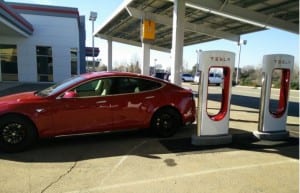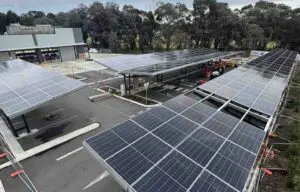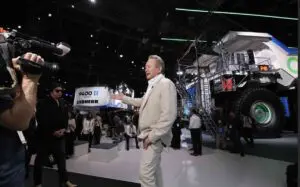As industry transitions go, the shift from the internal combustion engine to electric vehicles, from single ownership to shared asset, and from human driving to robotics and software, is going to be as big as they come.
This is not just a multi-billion dollar market, but a multi-trillion dollar one – more than $10 trillion if some analysts are to be believed. It will impact the oil industry, and the car industry. And it will filter down to the electricity industry and home energy systems, because battery storage will become so endemic. It will also redefine the way we live and drive.

The current model of car ownership is expensive, dangerous, and inefficient, according to Morgan Stanley analysts. Cars are used sparingly, they take a huge amount of time when they are in use, they pollute (using 45 per cent of all oil use) and they are deadly (at least 1.3 million deaths a year).
The shared mobility market is likely to be driven by three irresistible trends that address these very problems.
The first is the concept of shared vehicles, and a giant leap in the business model from cars sold to a business model based on miles, or kilometres, travelled. Kind of like iPhones on wheels.
 Cars are now expensive assets, and they are used for less than one hour a day, Morgan Stanley analysts note. That translates into a utilisation rate of less than 4 per cent, a figure that has remained largely unchanged for a century.
Cars are now expensive assets, and they are used for less than one hour a day, Morgan Stanley analysts note. That translates into a utilisation rate of less than 4 per cent, a figure that has remained largely unchanged for a century.
“The shared mobility model moves the transportation business from a privately owned and operated model to a professional service run by large firms engaged in mega-fleet management,” the analysts say in a recent report.
The second trend is autonomous vehicles, which are just perfect to tap into the full potential of shared vehicles, and will lift vehicle utilisation rates to 50-60 per cent.
This, of course, can’t be done with a human driver. Logistics won’t allow it, and the human factor is the biggest single cost of ride sharing services. “Replace the driver with a few million lines of code and some commoditised sensors and the savings can really begin,” Morgan Stanley analysts note.
The third, equally important factor is the emergence of electric vehicles and the downfall of the internal combustion engine.
EVs are currently hurt by low gas prices and high paybacks (for those who worry about such things). These are the iPhones on wheels that are bringing with them the new autonomous driving technologies and the opportunity to think differently about business models.
So, as vehicular mobility moves from private ownership to professional fleets of millions of vehicles that provide an on-demand service, firms will be able to amortise the costs of technologies and the infrastructure.
That’s critical. Instead of EVs being considered to be an indulgence beyond the finances of most drivers, paybacks for shared vehicles shrink to as little as three years, encouraging mass production of battery packs, which will then flow through to lower costs for energy storage.
Shared autonomous fleets also address many other problems with today’s EV model, such as slower charging time, lower charging station density and range limitation. And they will address issues such as crowded streets and growing populations.
 Morgan Stanley predicts that by 2030, more than 20 per cent of all miles travelled in Europe will be shared. In the US and India, it will be 25 per cent. In China, it will be more than 34 per cent.
Morgan Stanley predicts that by 2030, more than 20 per cent of all miles travelled in Europe will be shared. In the US and India, it will be 25 per cent. In China, it will be more than 34 per cent.
But where and how might this happen first?
One regular correspondent of RenewEconomy’s, who prefers to remain anonymous, suggested that Manhattan could be an obvious place to start.
“Suppose that a number of major arteries in a town were cordoned off strictly for the use of autonomous vehicles, much the way that only trains now run on railroad tracks,” our correspondent writes.
“This would mean that nearly every place in town could be within a few blocks of such an artery if desired.
“Note that this is essentially what Manhattan already has with its subway system. Every place on the island is just a short walk from a subway stop, and, as a result, comparatively few residents bother even owning a car, much less driving it just to cross town a few miles. I lived there myself for a couple of years, and can attest that this really is the case, and I myself did not bother with a car. Even when I moved out to the suburbs I still just walked a mile to the train station, and then rode the commuter train into the city for work.
“Anyway, by limiting autonomous cars only to a strictly defined set of routes, a huge number of private cars would indeed become quite unnecessary, and the costs of owning a car would not be justifiable for the majority of people in such a city.
“Some functions, such as trash pickup and mail delivery, would still require human-operated vehicles to operate on the non-automated streets, and some people might need assistance getting from their homes either to the public transit system, or all the way to their destination.
“By this I mean mostly the elderly, the handicapped, and those with large burdens such as furniture or appliances to be moved. However, all these things are special cases, which are relatively infrequent and, again, cities like Manhattan demonstrate that such things can be handled effectively enough.
“So, while there might still be some human drivers in the system for commercial functions like trash, mail, ambulances, and package deliveries, you could probably ban all private vehicles in such a city with large financial savings for all, and very little inconvenience for anyone.
“The joke of course is that autonomous vehicles would just be an expensive way of doing what trains have been doing for 150 years or so.
“The real trick is not technological, but political. All you really have to do is to ban private vehicles in the city, and the rest follows naturally from that one constraint.
“Problem is that until now the auto industry had too much clout to let that happen, which is why it is outsiders like Google, Apple, and Tesla who will be the ones to force a change on the traditional auto companies.”
And it is exactly that political constraint, and the fact that this is likely to be driven by auto industry outsiders, that leads Morgan Stanley to believe that the first trials are likely to happen in “progressive” towns such as Austin, Texas, or Mountain View, California, the home of Google.
The Morgan Stanley analysts suggest a trial in a small area, probably defined by a couple of kilometres squared.
The vehicles would have no driver, no steering wheel, no pedals. Just seats for passengers. And they would be hailed via a ride-sharing app from your smart phone.
The fleets would start small, with as few as 20 to 100 cars and be speed limited – possibly to a maximum of 40kmh to ensure safety. And they would be range limited.
They would be funded by large, highly capitalised tech firms (Google, or Apple, which is investing more in autonomous vehicles than it has on all its other smart devices combines) who can approach such a venture as pure R&D, and where up-front financial losses “would be potentially less than a rounding error.”
Morgan Stanley expects the first cars would be quite over-engineered with redundant safety systems.
“While some autonomous applications can cost as little as $US2,000/car, we expect these first units to be a multiple of the cost of a normal car, potentially hundreds of thousands of dollars including back-end software and development costs.
“Expect such cars to be equipped with a suite of LIDAR, RADAR, encrusted with cameras and sensors driven by a connected super-computer capable of continuous software updates and machine learning.”
Interestingly, Morgan Stanley suggests that there will be minimal to no infrastructure augmentations required of the governing metropolitan area, at least at first.
Once these trial projects are proven, the second stage implementation can occur at higher speeds, larger areas and new routes, such as between transport hubs, and airport runs.










